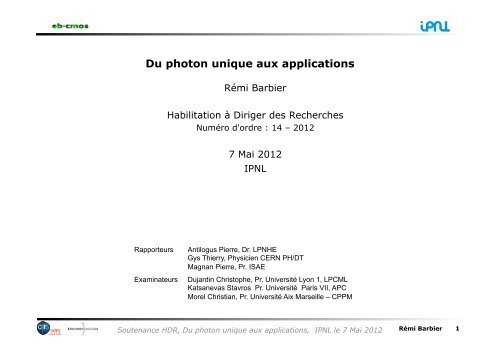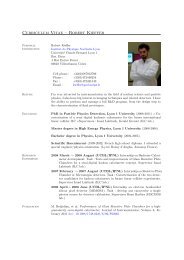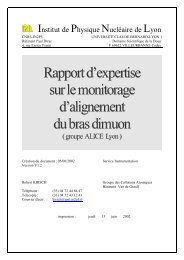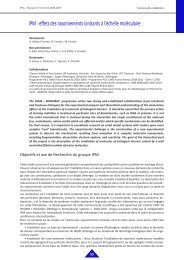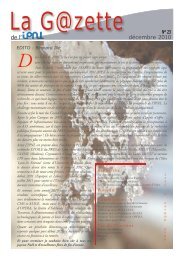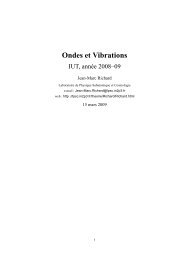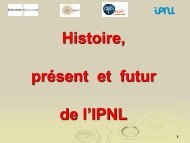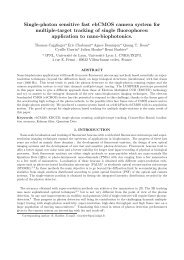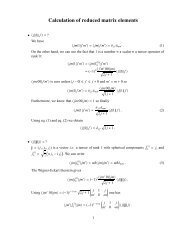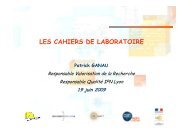Du photon unique aux applications - IPNL
Du photon unique aux applications - IPNL
Du photon unique aux applications - IPNL
Create successful ePaper yourself
Turn your PDF publications into a flip-book with our unique Google optimized e-Paper software.
<strong>Du</strong> <strong>photon</strong> <strong>unique</strong> <strong>aux</strong> <strong>applications</strong><br />
Rémi Barbier<br />
Habilitation à Diriger des Recherches<br />
Numéro d'ordre : 14 – 2012<br />
7 Mai 2012<br />
<strong>IPNL</strong><br />
Rapporteurs Antilogus Pierre, Dr. LPNHE<br />
Gys Thierry, Physicien CERN PH/DT<br />
Magnan Pierre, Pr. ISAE<br />
Examinateurs <strong>Du</strong>jardin Christophe, Pr. Université Lyon 1, LPCML<br />
Katsanevas Stavros Pr. Université Paris VII, APC<br />
Morel Christian, Pr. Université Aix Marseille – CPPM<br />
Soutenance HDR, <strong>Du</strong> <strong>photon</strong> <strong>unique</strong> <strong>aux</strong> <strong>applications</strong>, <strong>IPNL</strong> le 7 Mai 2012<br />
Rémi Barbier 1
Plan<br />
1. Présentation du parcours et du cadre de la R&D ebCMOS<br />
2. Détection de <strong>photon</strong>s <strong>unique</strong>s : Single-Photon Imaging (SPI)<br />
a. SPI & ebCMOS<br />
1. SPI ?<br />
2. ebCMOS : principe<br />
3. ebCMOS : en pratique<br />
b. Caractérisations des BSI CMOS & ebCMOS<br />
c. Prototypes de caméras & système d’acquisition<br />
d. Algorithmes pour la SPI :études off-line<br />
e. Implémentation temps réel<br />
3. Applications<br />
a. Suivi de Nanoparticules<br />
b. Etude Nage de Bactéries<br />
c. SPI Bas Bruit & bioluminescence : système embarqué<br />
4. Conclusion<br />
Soutenance HDR, <strong>Du</strong> <strong>photon</strong> <strong>unique</strong> <strong>aux</strong> <strong>applications</strong>, <strong>IPNL</strong> le 7 Mai 2012<br />
Rémi Barbier 2
Thématiques : 3 vies<br />
1. Parcours (1/1)<br />
1993 1995 1997 2000 2002 2005<br />
2008<br />
2012<br />
Doctorat : 2 ans<br />
Post-Doc : 2 ans<br />
MCF : 15 ans<br />
théorie DELPHI mPET ebMIMOSA5 lusipher<br />
• 19 ans de recherche et d’enseignement<br />
• Pas de mobilité géographique … mais … mobilité thématique par 2 fois !<br />
1. Algèbre quantique<br />
2. Physique des particules : analyse de données SUSY, RPV<br />
3. Instrumentation photodétecteurs : MaPMT et DAQ, HPD pour module<br />
mPET<br />
4. R&D ebCMOS :<br />
1. preuve de faisabilité<br />
2. preuve de concept<br />
• Responsabilités :<br />
Coord. DELPHI R-Parity Violating SUSY Working Group (3 analyses)<br />
Coord. mPET (création Imabio): ACI Technologie pour la santé mPET<br />
Création et Coord. du «groupe» ebCMOS<br />
Encadrement M2 et Doctorat<br />
Soutenance HDR, <strong>Du</strong> <strong>photon</strong> <strong>unique</strong> <strong>aux</strong> <strong>applications</strong>, <strong>IPNL</strong> le 7 Mai 2012<br />
Rémi Barbier 3
PARTENAIRES R&D<br />
IPHC :<br />
Marc Winter<br />
Wojtek <strong>Du</strong>linski<br />
Jérôme Baudot<br />
Marie-Hélène Sigward<br />
Andrei Dorhokov<br />
Gilles Claus<br />
Mathieu Goffe<br />
Marcel Trimpl<br />
Christine Hu<br />
SAGEM :<br />
Eric Carré<br />
Stéphane Demiguel<br />
Oscar Dalméida<br />
PHOTONIS :<br />
Nicolas Laurent<br />
Patrick Clauzel<br />
Carlo Kaiser<br />
Franck Robert<br />
Bruno Combettes<br />
Christophe Fontaine<br />
DGA :<br />
Rose-Marie Sauvage<br />
Liste ebCMOS<br />
@ <strong>IPNL</strong> :<br />
Nicolas Estre<br />
Agnès Dominjon<br />
Eric Chabanat<br />
Pierre Depasse<br />
Quang Tuyen Doan<br />
Thomas Cajgfinger<br />
Romain Cluzel<br />
Timothée Brugière<br />
Richard Vallot<br />
Mohamed Said Harouaz<br />
Maxime Ignacio<br />
Michel Ageron<br />
David Chaize<br />
Peter Calabria<br />
Lionel Vagneron<br />
Alain Benoit<br />
Sylvain Vanzetto<br />
Cyrille Guérin<br />
William Tromeur<br />
Sylvain Fériol<br />
Julien Houles<br />
Didier Bon<br />
Didier Delaunay<br />
Rodolphe Della Negra<br />
Vadim Odoubovski<br />
Stavros Katsanevas<br />
Jean-Eudes Augustin<br />
Yves Déclais<br />
Bernard Ille<br />
APPLICATIONS<br />
Soutenance HDR, <strong>Du</strong> <strong>photon</strong> <strong>unique</strong> <strong>aux</strong> <strong>applications</strong>, <strong>IPNL</strong> le 7 Mai 2012<br />
NanoOptec :<br />
Christophe <strong>Du</strong>jardin<br />
David Amans<br />
Gilles Ledoux<br />
Florian Kulzer<br />
ENS lyon :<br />
Laurence Lemelle<br />
Christophe Place<br />
ENS Ulm:<br />
Maxime Dahan<br />
Ignacio Izeddin<br />
IGBMC:<br />
Angela Giangrande<br />
Jean Luc Voenech<br />
ANTARES :<br />
Juergen Brunner<br />
CCQ UCBL :<br />
Yves Tourneur<br />
Rémi Barbier 4
Le projet de R&D ebCMOS est varié !<br />
Technologies :<br />
• CMOS Cahier des charges<br />
• Tube<br />
CMOS<br />
• DAQ FPGA<br />
Tube<br />
• Instrumentation<br />
• Logiciel DAQ<br />
Banc Tests<br />
• Syst. embarqué<br />
Méthodes :<br />
• Caractérisation<br />
• Tracking<br />
• DAQ Clust.<br />
Management :<br />
• Montages projets<br />
• Collab. Industriels<br />
• Brevet<br />
• Transfer<br />
• Coordination<br />
Algorithme de<br />
tracking<br />
Processing RT<br />
GPU<br />
1. Cadre de la R&D ebCMOS (2/2)<br />
GUI<br />
Collaboration<br />
Indus.<br />
Logiciel<br />
d'acquisition<br />
Reception<br />
Haut-débit<br />
Optimisation<br />
Haut-débit<br />
Processing sur<br />
carte<br />
OA<br />
Système<br />
d'acqusition<br />
ebCMOS<br />
Applications<br />
Syst.<br />
embarqué<br />
Optique<br />
Instrumentation<br />
Caméra<br />
caractérisation<br />
Wave front<br />
Sensor<br />
QDots<br />
3D imaging<br />
Bactéries<br />
Conception<br />
carte<br />
Dynamique<br />
mvt Brownien<br />
Bioluminescen<br />
ce<br />
Superesolution<br />
Conception &<br />
mécanique<br />
pilotage<br />
Soutenance HDR, <strong>Du</strong> <strong>photon</strong> <strong>unique</strong> <strong>aux</strong> <strong>applications</strong>, <strong>IPNL</strong> le 7 Mai 2012<br />
BackScattering<br />
Tube<br />
BSI CMOS<br />
couche de<br />
passivation<br />
Retour<br />
Ionique<br />
Gain<br />
PSF<br />
Cathode<br />
epilayer<br />
PSF CMOS<br />
Rémi Barbier 5
Objectifs de la R&D ebCMOS<br />
Explorer les conditions extrêmes de l’imagerie : SPI<br />
rapidité<br />
sensibilité<br />
quantification<br />
haut débit de données<br />
Applications ciblées<br />
Microscopie de fluorescence, OA, bioluminescence,<br />
vidéo-microscopie …<br />
Méthode<br />
Suivi (tracking) de sources lumineuses<br />
Par accumulations « des <strong>photon</strong>s <strong>unique</strong>s »<br />
Domaine de la SPI<br />
(1-20 <strong>photon</strong>s par « cible » et par trame)<br />
Identifier - Localiser - Suivre – Quantifier<br />
Moyen<br />
Le tracking par caméra : ebCMOS<br />
Des sources d’erreurs sur les mesures :<br />
• l’identification :<br />
Bruit DC<br />
Compromis : Efficacité / Pureté<br />
• la localisation :<br />
Pixel et PSF<br />
Compromis : fréq. im./nbre ph.<br />
• le suivi :<br />
Rapidité & Haut-débit<br />
Compromis : vitesse / précision<br />
• la quantification :<br />
Gain & ENF<br />
Compromis : gain / ENF<br />
gain /dynamique<br />
Soutenance HDR, <strong>Du</strong> <strong>photon</strong> <strong>unique</strong> <strong>aux</strong> <strong>applications</strong>, <strong>IPNL</strong> le 7 Mai 2012<br />
Rémi Barbier 6
La « rose » des contraintes toujours plus contradictoires<br />
• bruit de lecture<br />
• # <strong>photon</strong>s / image<br />
• flux Gbits/s<br />
PRECIS<br />
• taille pixels<br />
• limite de diffraction<br />
• # <strong>photon</strong>s / source<br />
• Identification & suivi<br />
• Comptage ?<br />
RAPIDE<br />
PLUS<br />
PLUS<br />
PLUS<br />
SENSIBLE<br />
• Meilleur suivi<br />
• Meilleur infor. Temporelle<br />
• Comptage<br />
emCMOS sCMOS<br />
• # pixels<br />
maPMT<br />
APDs<br />
• Meilleur localisation<br />
• flux Gbits/s<br />
• fréquence trame<br />
emCCD<br />
MCP<br />
SPAD<br />
SPAD<br />
LARGE<br />
Soutenance HDR, <strong>Du</strong> <strong>photon</strong> <strong>unique</strong> <strong>aux</strong> <strong>applications</strong>, <strong>IPNL</strong> le 7 Mai 2012<br />
• FOV<br />
• du nombre de sources<br />
ICCD<br />
• bruit lié au gain et au capteur<br />
• Dynamique<br />
• Sensibilité <strong>aux</strong> ph. parasites<br />
Rémi Barbier 7
<strong>Du</strong> concept au schéma de principe<br />
ebCMOS<br />
CMOS electro-bombardé<br />
LUSIPHER : Large Scale Ultra-fast<br />
SIngle-PHotoelectron recordER<br />
Schéma de principe<br />
Soutenance HDR, <strong>Du</strong> <strong>photon</strong> <strong>unique</strong> <strong>aux</strong> <strong>applications</strong>, <strong>IPNL</strong> le 7 Mai 2012<br />
Rémi Barbier 8
Plan<br />
1. Présentation du parcours et du cadre de la R&D ebCMOS<br />
2. Détection de <strong>photon</strong>s <strong>unique</strong>s : Single-Photon Imaging (SPI)<br />
a. SPI & ebCMOS<br />
1. SPI ?<br />
2. ebCMOS : principe<br />
3. ebCMOS : en pratique<br />
b. Caractérisations des BSI CMOS & ebCMOS<br />
c. Prototypes de caméras & système d’acquisition<br />
d. Algorithmes pour la SPI :études off-line<br />
e. Implémentation temps réel<br />
3. Applications<br />
a. Suivi de Nanoparticules<br />
b. Etude Nage de Bactéries<br />
c. SPI Bas Bruit & bioluminescence : système embarqué<br />
4. Conclusion<br />
Soutenance HDR, <strong>Du</strong> <strong>photon</strong> <strong>unique</strong> <strong>aux</strong> <strong>applications</strong>, <strong>IPNL</strong> le 7 Mai 2012<br />
Rémi Barbier 9
Single-Photon Imaging : détecteur 2D<br />
Détecter le <strong>photon</strong> <strong>unique</strong> :<br />
2. Détection de <strong>photon</strong>s - 2.a. SPI & ebCMOS<br />
Les étapes de la détection du <strong>photon</strong> apportent<br />
- des sources de bruit<br />
&<br />
- des inefficacités sur la collection du signal<br />
FLUX<br />
Night Level #ph/mm 2 /s #ph/pixel*/ms microLux<br />
overcast starlight 1,30E+06 1,30E-01 1,00E+02<br />
Csorba<br />
Soutenance HDR, <strong>Du</strong> <strong>photon</strong> <strong>unique</strong> <strong>aux</strong> <strong>applications</strong>, <strong>IPNL</strong> le 7 Mai 2012<br />
starlight 1,30E+07 1,30E+00 1,00E+03<br />
quarter moon 1,30E+08 1,30E+01 1,00E+04<br />
full moon 1,30E+09 1,30E+02 1,00E+05<br />
deep twilight 1,30E+10 1,30E+03 1,00E+06<br />
twilight 1,30E+11 1,30E+04 1,00E+07<br />
very dark day 1,30E+12 1,30E+05 1,00E+08<br />
overcast day 1,30E+13 1,30E+06 1,00E+09<br />
daylight 1,30E+14 1,30E+07 1,00E+10<br />
direct sunlight 1,30E+15 1,30E+08 1,00E+11<br />
* pixel=10 micron de pitch<br />
TUTO RB<br />
PHOTODETECTION<br />
NDIP 2011 LYON<br />
Rémi Barbier 10
Probability<br />
0.06<br />
0.05<br />
0.04<br />
0.03<br />
0.02<br />
0.01<br />
0<br />
EMCCD<br />
Pixels<br />
Storage<br />
Number of Imput e-<br />
1 (MC)<br />
1 (Theory)<br />
2 (MC)<br />
2 (Theory)<br />
3 (MC)<br />
3 (Theory)<br />
4 (MC)<br />
4 (Theory)<br />
5 (MC)<br />
5 (Theory)<br />
6 (MC)<br />
6 (Theory)<br />
La technologie mature : emCCD<br />
Impact ionisation<br />
de prob. P par clk<br />
R3 R1 dc R2 R3 R1<br />
V<br />
Shift register Gain register<br />
pdf<br />
G=(1+P) 512 =1000<br />
P=1.3%<br />
Doctorat T.C. 2012<br />
500 1000 1500<br />
Number of Output e-<br />
2000 2500 3000<br />
ANDOR iXon DU 897BI (512x512/ 16um) puce E2V<br />
Dark Current @ -85C (e-/pix/s) = 0.001<br />
Clock Induced Charge (evt/pix) = 0.005<br />
EM =x1000 / T=-85°C / Tint=30 ms<br />
CIC = 1310 fake/frame<br />
DC = 649 Hz/mm 2<br />
ANDOR DU860 (500fps/128x128/24 um)<br />
CIC = 0.02 evt/pix<br />
DC = 2.6 kHz/mm 2<br />
Soucis sur :<br />
500 1000 1500<br />
Number of Output e-<br />
2000 2500 3000<br />
électrons secondaires = gain em<br />
Soutenance HDR, <strong>Du</strong> <strong>photon</strong> <strong>unique</strong> <strong>aux</strong> <strong>applications</strong>, <strong>IPNL</strong> le 7 Mai 2012<br />
Probability<br />
0.009<br />
0.008<br />
0.007<br />
0.006<br />
0.005<br />
0.004<br />
0.003<br />
0.002<br />
pdf<br />
Bruit de comptage !<br />
Vitesse !<br />
Comptage !<br />
Mean Poisson Signal = 5<br />
(MC)<br />
(Theory)<br />
Poisson<br />
mean = 5 ph.<br />
e-<br />
Rémi Barbier 12
Plan<br />
1. Présentation du parcours et du cadre de la R&D ebCMOS<br />
2. Détection de <strong>photon</strong>s <strong>unique</strong>s : Single-Photon Imaging (SPI)<br />
a. SPI & ebCMOS<br />
1. SPI ?<br />
2. ebCMOS : principe<br />
3. ebCMOS : en pratique<br />
b. Caractérisations des BSI CMOS & ebCMOS<br />
c. Prototypes de caméras & système d’acquisition<br />
d. Algorithmes pour la SPI :études off-line<br />
e. Implémentation temps réel<br />
3. Applications<br />
a. Suivi de Nanoparticules<br />
b. Etude Nage de Bactéries<br />
c. SPI Bas Bruit & bioluminescence : système embarqué<br />
4. Conclusion<br />
Soutenance HDR, <strong>Du</strong> <strong>photon</strong> <strong>unique</strong> <strong>aux</strong> <strong>applications</strong>, <strong>IPNL</strong> le 7 Mai 2012<br />
Rémi Barbier 13
2. Détection de <strong>photon</strong>s – 2.a. ebCMOS : en principe<br />
L’ebCMOS est le dernier né de la famille des<br />
HPD : Capteur Hybride : PK+HV+Silicium<br />
• type HPD (CERN DEP)<br />
• INTEVAC : EBAPS<br />
• HAMAMATSU : ebCCD<br />
!!!!!"#$%&#'!()*+,*-./-#!011!µ$!<br />
p.e.<br />
5#/'!6/7#.!81!4$! P++ doped layer : passivation<br />
;!µm!!<br />
():#66!?%.!!<br />
9)@AB!C!<br />
9):#66!'2%'#!<br />
1 pixel 10µm<br />
():#66!?%.!!<br />
9)@AB!C!<br />
9):#66!'2%'#!<br />
Substrate for back-side etching<br />
P-doped graduated layer<br />
#)!'23+*2%4!<br />
e- collection<br />
():#66!?%.!!<br />
9)@AB!C!<br />
ebCMOS<br />
10 mm<br />
multiplication<br />
window<br />
<strong>photon</strong><br />
photo-electron<br />
Ceramic carrier<br />
Secondary electron<br />
produced in 0.1 µm 3<br />
reset<br />
vdd<br />
gnd<br />
vdd<br />
3T (N-MOS ) pixel<br />
Impact position<br />
photocathode<br />
BSB-CMOS<br />
1 cm 2 – 10 6 Pixels<br />
Soutenance HDR, <strong>Du</strong> <strong>photon</strong> <strong>unique</strong> <strong>aux</strong> <strong>applications</strong>, <strong>IPNL</strong> le 7 Mai 2012<br />
select<br />
output<br />
!"#!$%#&"'$$<br />
+,)-&.(/0-&<br />
!"#$"%&'("<br />
vacuum<br />
Interposer<br />
416$789$&<br />
:;;?&<br />
!"#$%%&'()'$*&<br />
!<br />
" #$<br />
%<br />
& !<br />
'(<br />
HV<br />
Rémi Barbier 14
2. Détection de <strong>photon</strong>s – 2.a. ebCMOS : en principe<br />
Courbes d’iso-résolution en fonction du gap (cathode-CMOS) et de la HT<br />
Gain<br />
V<br />
Bruit<br />
&<br />
Xray<br />
Passivation<br />
V (keV)<br />
6<br />
résolution<br />
5<br />
4<br />
3<br />
2<br />
1<br />
sigma = 5 micron<br />
sigma = 1 micron<br />
E=10kV/mm<br />
Vmin = 1,2 keV<br />
sigma = 5 microns<br />
Vmax = 1,8 keV<br />
sigma = 10 micron<br />
Sigma < 15 microns - sigma limite 1 micron – sans dead layer<br />
E=4kV/mm<br />
sigma = 10 microns<br />
Vmax 3 keV<br />
sigma = 15 microns<br />
sigma = 20 microns<br />
0 0,25 0,5 0,75 1 1,25 d (mm) 1,5<br />
Bruit DC augmente<br />
Soutenance HDR, <strong>Du</strong> <strong>photon</strong> <strong>unique</strong> <strong>aux</strong> <strong>applications</strong>, <strong>IPNL</strong> le 7 Mai 2012<br />
A l’ordre 1 !<br />
PSF Tube :<br />
GAP (200 um)<br />
PSF CMOS<br />
+ Gain<br />
Dead Layer (10 nm)<br />
Epi layer (2-3 um)<br />
Pitch (5 um)<br />
DC<br />
GAP<br />
Rémi Barbier 15
Plan<br />
1. Présentation du parcours et du cadre de la R&D ebCMOS<br />
2. Détection de <strong>photon</strong>s <strong>unique</strong>s : Single-Photon Imaging (SPI)<br />
a. SPI & ebCMOS<br />
1. SPI ?<br />
2. ebCMOS : principe<br />
3. ebCMOS : en pratique<br />
b. Caractérisations des BSI CMOS & ebCMOS<br />
c. Prototypes de caméras & système d’acquisition<br />
d. Algorithmes pour la SPI :études off-line<br />
e. Implémentation temps réel<br />
3. Applications<br />
a. Etude Nage de Bactéries<br />
b. SPI Bas Bruit & bioluminescence : système embarqué<br />
c. SPI Bas Bruit & bioluminescence : système embarqué<br />
4. Conclusion<br />
Soutenance HDR, <strong>Du</strong> <strong>photon</strong> <strong>unique</strong> <strong>aux</strong> <strong>applications</strong>, <strong>IPNL</strong> le 7 Mai 2012<br />
Rémi Barbier 17
2. Détection de <strong>photon</strong>s – 2.a. ebCMOS : en pratique<br />
MIMOSA5 Aminci<br />
– IPHC 2003<br />
!""#!""$ !""#!""$<br />
Soutenance HDR, <strong>Du</strong> <strong>photon</strong> <strong>unique</strong> <strong>aux</strong> <strong>applications</strong>, <strong>IPNL</strong> le 7 Mai 2012<br />
!)*'$µ($<br />
4 outputs<br />
Lucy FSI et BSI<br />
– IPHC et al. 2007<br />
6,2$7189$<br />
%!&'$µ($<br />
+,-./0123$-415$<br />
4 outputs<br />
Rémi Barbier 18
2. Détection de <strong>photon</strong>s – 2.a. ebCMOS : en pratique<br />
Les débuts furent difficiles … pas que pour nous d’ailleurs …<br />
Impuretés<br />
Défaut CMOS<br />
Un bonding en moins<br />
Une matrice de perdue<br />
Soutenance HDR, <strong>Du</strong> <strong>photon</strong> <strong>unique</strong> <strong>aux</strong> <strong>applications</strong>, <strong>IPNL</strong> le 7 Mai 2012<br />
Cathode<br />
Rémi Barbier 19
Plan<br />
1. Présentation du parcours et du cadre de la R&D ebCMOS<br />
2. Détection de <strong>photon</strong>s <strong>unique</strong>s : Single-Photon Imaging (SPI)<br />
a. SPI & ebCMOS<br />
1. SPI ?<br />
2. ebCMOS : principe<br />
3. ebCMOS : en pratique<br />
b. Caractérisations des BSI CMOS & ebCMOS<br />
c. Prototypes de caméras & système d’acquisition<br />
d. Algorithmes pour la SPI :études off-line<br />
e. Implémentation temps réel<br />
3. Applications<br />
a. Suivi de Nanoparticules<br />
b. Etude Nage de Bactéries<br />
c. SPI Bas Bruit & bioluminescence : système embarqué<br />
4. Conclusion<br />
Soutenance HDR, <strong>Du</strong> <strong>photon</strong> <strong>unique</strong> <strong>aux</strong> <strong>applications</strong>, <strong>IPNL</strong> le 7 Mai 2012<br />
Rémi Barbier 20
2. Détection de <strong>photon</strong>s – 2.b. (eb)CMOS : caractérisation<br />
Que caractérise-t-on ?<br />
Activité de transfert :<br />
• Photonis<br />
• Sagem DS<br />
Le futur de la caractérisation du groupe ebCMOS :<br />
• Recouper nos mesures avec des méthodes plus<br />
standard : PTC …<br />
• Développer des méthodes de mesures<br />
– du gain em et ENF<br />
– de la PDE<br />
• Ne pas confondre :<br />
– L’expertise<br />
– La prestation de mesures<br />
Sources<br />
capteur<br />
– La collaboration de recherche<br />
Pixel Fact. Conv.<br />
CCE<br />
Face arrière<br />
BSI CMOS<br />
X Fe 55 électrons optique<br />
Gain mult.<br />
Passivation<br />
CCE<br />
Soutenance HDR, <strong>Du</strong> <strong>photon</strong> <strong>unique</strong> <strong>aux</strong> <strong>applications</strong>, <strong>IPNL</strong> le 7 Mai 2012<br />
PSF CMOS<br />
Tube PSF Tube<br />
Bruit PK<br />
Rémi Barbier 21
2. Détection de <strong>photon</strong>s – 2.b. (eb)CMOS : caractérisation<br />
• Absolute calibration<br />
electron/ADCU<br />
• Charge collection efficiency<br />
estimation<br />
Charge collected in one diode<br />
XRay full<br />
energy peak<br />
Charge collected in 5x5 diodes<br />
! Diode Conversion Factor<br />
C = 4,6 e - / ADC<br />
! Charge Collection Efficiency<br />
CCE XRay =<br />
Q (cluster 5x5 pixels)<br />
Q (diode 100%)<br />
XRay cluster charge 5x5 Epilayer resistivity Standard Resistive Profiled<br />
CCE XRay 32 % 25 % 60 %<br />
CCE XRay increased by a factor 2<br />
for profiled epilayer resistivity<br />
Agnès Dominjon. IEEE 2009<br />
Soutenance HDR, <strong>Du</strong> <strong>photon</strong> <strong>unique</strong> <strong>aux</strong> <strong>applications</strong>, <strong>IPNL</strong> le 7 Mai 2012<br />
Rémi Barbier 22
2. Détection de <strong>photon</strong>s – 2.b. (eb)CMOS : caractérisation<br />
Le Banc Bombardement<br />
électronique :<br />
Permet d’ étudier les BSI sans<br />
fabriquer un tube !<br />
Permet l’étude des<br />
passivations<br />
Permet l’étude des couches épi<br />
Permet d’étudier les design<br />
pixels (CCE)<br />
L’analyse événement électron <strong>unique</strong><br />
n’est pas standard dans l’optronique<br />
(transfert SAGEM).<br />
Soutenance HDR, <strong>Du</strong> <strong>photon</strong> <strong>unique</strong> <strong>aux</strong> <strong>applications</strong>, <strong>IPNL</strong> le 7 Mai 2012<br />
Rémi Barbier 23
2. Détection de <strong>photon</strong>s – 2.b. (eb)CMOS : caractérisation<br />
Etude passivation<br />
Doctorat CIFRE<br />
R. Cluzel (2010)<br />
La confidentialité … la science du A, B, C, D … vive la A !<br />
Energie d’implantation du Bore, intensité du laser, durée, pré-amorphisation Ge<br />
Le profil de dopage pas si crucial … si inférieur à 10-20 nm !<br />
Rémi Barbier 24
XYZ<br />
2. Détection de <strong>photon</strong>s – 2.b. (eb)CMOS : caractérisation<br />
50X LWD Mitutoyo<br />
EBCMOS<br />
Comparaison Diffusion TCAD vs DATA<br />
EXCELLENTE !<br />
N. Estre A. Dorhokov<br />
Image of the spot<br />
FWHM < 1 µm<br />
Post Doc : N. Estre 2007<br />
Rémi Barbier 25
p.d.f<br />
2. Détection de <strong>photon</strong>s – 2.b. (eb)CMOS : caractérisation<br />
PSF CMOS + PSF Tube<br />
0.08<br />
0.07<br />
0.06<br />
0.05<br />
0.04<br />
0.03<br />
0.02<br />
0.01<br />
0<br />
Spot<br />
FWHM = 9.2 µ m<br />
Data<br />
2<br />
Fit ( ! /ndf = 51.3/46)<br />
Angular distr. func.<br />
" = 2.7 (0.1) µ m<br />
-20 -10 0 10 20<br />
Spot position ( µ m)<br />
A. Dominjon 2011<br />
NIM A 2011<br />
Q.T. Doan 2011<br />
-60 -40 -20 0 20 40 60<br />
Pixel position ( µ m)<br />
Soutenance HDR, <strong>Du</strong> <strong>photon</strong> <strong>unique</strong> <strong>aux</strong> <strong>applications</strong>, <strong>IPNL</strong> le 7 Mai 2012<br />
p.d.f<br />
0.04<br />
0.035<br />
0.03<br />
0.025<br />
0.02<br />
0.015<br />
0.01<br />
0.005<br />
0<br />
FWHM = 30.0 µ m<br />
! Tube = 10.5 ± 0.5 µ m<br />
Data<br />
Fit ( " 2/ndf<br />
= 6.6/10)<br />
R. Vallot<br />
2009<br />
Rémi Barbier 26
2. Détection de <strong>photon</strong>s – 2.b. (eb)CMOS : caractérisation<br />
Le problème de la rétrodiffusion : Brevet Intevac : (grille sur BSI CMOS)<br />
• Brevet R.B. & N.E. (méthode SPI)<br />
Q versus rayon pour différentes intensités de halo<br />
Soutenance HDR, <strong>Du</strong> <strong>photon</strong> <strong>unique</strong> <strong>aux</strong> <strong>applications</strong>, <strong>IPNL</strong> le 7 Mai 2012<br />
Rémi Barbier 27
2. Détection de <strong>photon</strong>s – 2.b. (eb)CMOS : caractérisation<br />
Calibration absolue : crist<strong>aux</strong> non linéaire BBO :<br />
mesure QE, PDE pour SPAD, PMT, emCCD, sCMOS…<br />
Pour l’IR (Migdall et al. NIST) ?<br />
Ouvre aussi des possibilités « science » :<br />
Sub-Poisson : (Oxford Univ. Walmsley et al., Blanchet<br />
Dev<strong>aux</strong> Femto-ST)<br />
Quantum imaging : (Brida et al. - Treps, Fabre et al. Ulm)<br />
Post Doc T. Brugière 2012<br />
Soutenance HDR, <strong>Du</strong> <strong>photon</strong> <strong>unique</strong> <strong>aux</strong> <strong>applications</strong>, <strong>IPNL</strong> le 7 Mai 2012<br />
Brida 2010<br />
Rémi Barbier 28
Plan<br />
1. Présentation du parcours et du cadre de la R&D ebCMOS<br />
2. Détection de <strong>photon</strong>s <strong>unique</strong>s : Single-Photon Imaging (SPI)<br />
a. SPI & ebCMOS<br />
1. SPI ?<br />
2. ebCMOS : principe<br />
3. ebCMOS : en pratique<br />
b. Caractérisations des BSI CMOS & ebCMOS<br />
c. Prototypes de caméras & système d’acquisition<br />
d. Algorithmes pour la SPI :études off-line<br />
e. Implémentation temps réel<br />
3. Applications<br />
a. Suivi de Nanoparticules<br />
b. Etude Nage de Bactéries<br />
c. SPI Bas Bruit & bioluminescence : système embarqué<br />
4. Conclusion<br />
Soutenance HDR, <strong>Du</strong> <strong>photon</strong> <strong>unique</strong> <strong>aux</strong> <strong>applications</strong>, <strong>IPNL</strong> le 7 Mai 2012<br />
Rémi Barbier 29
2. Détection de <strong>photon</strong>s <strong>unique</strong>s – 2.c. Prototypes caméras<br />
• Caméra ebMIMOSA5<br />
Vanzetto Estre 2008<br />
• Caméra LUSIPHER<br />
Vagneron Chaize Calabria Benoit 2010<br />
()**!+',)-./01'<br />
#8$)-02'<br />
6?>"&<br />
2340&5#$%"#6&)#*"(&<br />
78&9:3';&
2. Détection de <strong>photon</strong>s <strong>unique</strong>s – 2.c. Prototypes caméra<br />
Prototype LuSEApher sur la MII ANTARES<br />
Soutenance HDR, <strong>Du</strong> <strong>photon</strong> <strong>unique</strong> <strong>aux</strong> <strong>applications</strong>, <strong>IPNL</strong> le 7 Mai 2012<br />
En 4 mois : le syst. emb.<br />
Vagneron Chaize Calabria Houles Ageron<br />
Rémi Barbier 31
Digital CMOS<br />
Connections<br />
(option)<br />
Signal from CMOS<br />
LUSIPHER<br />
camera side<br />
sequencing<br />
analog data<br />
180 mm<br />
(7 in)<br />
Amplification<br />
and<br />
Digitization<br />
2. Détection de <strong>photon</strong>s <strong>unique</strong>s – 2.d. Syst. d’acquisition<br />
DAQ boards (Motherboard, 10 Gbit/s Eth, Slow Ctrl board)<br />
Data processing &<br />
CMOS sequencing<br />
Mother<br />
board<br />
314 mm (12.4 in)<br />
memories<br />
LUSIPHER<br />
camera side<br />
Slow control<br />
16 layers PCB<br />
3 functional systems produced<br />
Guérin, Tromeur, Mahroug (2010-2011-2012)<br />
Soutenance HDR, <strong>Du</strong> <strong>photon</strong> <strong>unique</strong> <strong>aux</strong> <strong>applications</strong>, <strong>IPNL</strong> le 7 Mai 2012<br />
Slow Ctrl.<br />
Mezz. board<br />
10 Gbit/s Ethernet<br />
Mezz. board<br />
Signal to WS<br />
Workstation<br />
side<br />
10Gbit Ethernet<br />
copper link (XAUI)<br />
CX4 -Data connectors processing<br />
- Memories<br />
- Ethernet frame<br />
encapsulation<br />
Rémi Barbier 32
Plan<br />
1. Présentation du parcours et du cadre de la R&D ebCMOS<br />
2. Détection de <strong>photon</strong>s <strong>unique</strong>s : Single-Photon Imaging (SPI)<br />
a. SPI & ebCMOS<br />
1. SPI ?<br />
2. ebCMOS : principe<br />
3. ebCMOS : en pratique<br />
b. Caractérisations des BSI CMOS & ebCMOS<br />
c. Prototypes de caméras & système d’acquisition<br />
d. Algorithmes pour la SPI :études off-line<br />
e. Implémentation temps réel<br />
3. Applications<br />
a. Suivi de Nanoparticules<br />
b. Etude Nage de Bactéries<br />
c. SPI Bas Bruit & bioluminescence : système embarqué<br />
4. Conclusion<br />
Soutenance HDR, <strong>Du</strong> <strong>photon</strong> <strong>unique</strong> <strong>aux</strong> <strong>applications</strong>, <strong>IPNL</strong> le 7 Mai 2012<br />
Rémi Barbier 33
2. Détection de <strong>photon</strong>s <strong>unique</strong>s – 2.e. Algorithmes<br />
Zoom frame brute<br />
Identification de sources par accumulation<br />
Frame 2 Frame 5 Frame 10<br />
State vector<br />
FILTRE DE KALMAN<br />
Clustering Photoelectron puis COG<br />
Photoelectron<br />
Measurement vector<br />
Position intra-pixel de la source<br />
Soutenance HDR, <strong>Du</strong> <strong>photon</strong> <strong>unique</strong> <strong>aux</strong> <strong>applications</strong>, <strong>IPNL</strong> le 7 Mai 2012<br />
Frame 1<br />
2µm<br />
Zoom (~4x4pixels)<br />
Rémi Barbier 34
€<br />
2. Détection de <strong>photon</strong>s <strong>unique</strong>s – 2.e. Algorithmes<br />
Estimation de la précision de localisation d’un émetteur <strong>unique</strong> statique :<br />
1. Limite de Cramèr-Rao : calcul de<br />
l’information de Fisher.<br />
⎡⎡ ∂ log f (x,θ)<br />
E ⎢⎢<br />
⎣⎣<br />
∂θ θ<br />
⎤⎤<br />
⎥⎥ = 0<br />
⎦⎦<br />
σ 2 > 1<br />
I(θ)<br />
⎡⎡<br />
2<br />
⎛⎛ ∂ log f (x,θ) ⎞⎞ ⎤⎤<br />
avec I(θ) = E ⎢⎢ ⎜⎜ ⎟⎟ ⎥⎥<br />
⎣⎣ ⎝⎝ ∂θ ⎠⎠ ⎦⎦<br />
2. Simulation Monte-Carlo<br />
– Paramètres €<br />
: source, optique,<br />
capteur<br />
– Variance de la position (barycentre)<br />
en fonction du nombre de <strong>photon</strong>s<br />
émis<br />
– Si N < 300ph le processus de<br />
multiplication impacte la résolution<br />
Simulation Monte Carlo de la précision<br />
de localisation pour un emCCD et un<br />
ebCMOS versus nbre ph.<br />
Sur capteur<br />
Localization accuracy [µm]<br />
Réf. : Pour CCD<br />
R.J. Ober, S. Ram, S. Ward, Biophysical journal V86 (2004) 1185<br />
Localisation accuracy in Single-Molecule Microscopy<br />
300ph<br />
Soutenance HDR, <strong>Du</strong> <strong>photon</strong> <strong>unique</strong> <strong>aux</strong> <strong>applications</strong>, <strong>IPNL</strong> le 7 Mai 2012<br />
α1/√N<br />
Number of emitted <strong>photon</strong>s<br />
Thèse T. Cajgfinger (2012)<br />
SPIE 2011<br />
Rémi Barbier 35
2. Détection de <strong>photon</strong>s <strong>unique</strong>s – 2.e. Algorithmes<br />
Photons reconstruits<br />
125 fps<br />
400x400 pixels<br />
SUR BANC OPTIQUE<br />
SOURCE de PHOTONS (Poisson) - SPOT 1 um<br />
Identification et « suivi »<br />
ZOOM 10x10 pixels<br />
Soutenance HDR, <strong>Du</strong> <strong>photon</strong> <strong>unique</strong> <strong>aux</strong> <strong>applications</strong>, <strong>IPNL</strong> le 7 Mai 2012<br />
Rémi Barbier 36
2. Détection de <strong>photon</strong>s <strong>unique</strong>s – 2.e. Algorithmes<br />
Identification après 30 ms<br />
de tracking :<br />
T<strong>aux</strong> d’erreurs < 10%<br />
Efficacité > 90%<br />
Thèse T. Cajgfinger (2012)<br />
SPIE 2011<br />
90%<br />
10%<br />
Pôle ORA - Journée Thématique - Bio<strong>photon</strong>ique, 7.02.12, ENSL<br />
2µm<br />
α1/√N<br />
Soutenance HDR, <strong>Du</strong> <strong>photon</strong> <strong>unique</strong> <strong>aux</strong> <strong>applications</strong>, <strong>IPNL</strong> le 7 Mai 2012<br />
Efficiency<br />
Pour<br />
différentes<br />
conditions<br />
de bruit<br />
Fake rate<br />
Time (ms)<br />
Signal [ph]<br />
80<br />
Rémi Barbier 37
2. Détection de <strong>photon</strong>s <strong>unique</strong>s – 2.e. Algorithmes<br />
Le comptage de <strong>photon</strong><br />
ebMIMOSA5<br />
Clustering par contour libre et non en 5x5 pixels.<br />
Puis probabilité d’association d’un pixel à un ph.e. :<br />
application du recuit déterministe Off-line :<br />
E. Chabanat 2009<br />
Cas plus réaliste :<br />
2 contours<br />
2 sources<br />
10 <strong>photon</strong>s<br />
Voie encore à explorer<br />
Soutenance HDR, <strong>Du</strong> <strong>photon</strong> <strong>unique</strong> <strong>aux</strong> <strong>applications</strong>, <strong>IPNL</strong> le 7 Mai 2012<br />
2 Quantum Dots<br />
On retrouve<br />
la charge d’un ph.e.<br />
Rémi Barbier 38
Plan<br />
1. Présentation du parcours et du cadre de la R&D ebCMOS<br />
2. Détection de <strong>photon</strong>s <strong>unique</strong>s : Single-Photon Imaging (SPI)<br />
a. SPI & ebCMOS<br />
1. SPI ?<br />
2. ebCMOS : principe<br />
3. ebCMOS : en pratique<br />
b. Caractérisations des BSI CMOS & ebCMOS<br />
c. Prototypes de caméras & système d’acquisition<br />
d. Algorithmes pour la SPI :études off-line<br />
e. Implémentation temps réel<br />
3. Applications<br />
a. Suivi de Nanoparticules<br />
b. Etude Nage de Bactéries<br />
c. SPI Bas Bruit & bioluminescence : système embarqué<br />
4. Conclusion<br />
Soutenance HDR, <strong>Du</strong> <strong>photon</strong> <strong>unique</strong> <strong>aux</strong> <strong>applications</strong>, <strong>IPNL</strong> le 7 Mai 2012<br />
Rémi Barbier 39
Hypothèses :<br />
2. Détection de <strong>photon</strong>s <strong>unique</strong>s – 2.d. Temps réel<br />
• Les émetteurs sont ponctuels (1.n x PSF) (Target Tracking)<br />
• Le nombre de <strong>photon</strong> reçus par émetteur par frame < 20 (SPI)<br />
mais pas obligatoirement <strong>unique</strong> par émetteur : complication pour le soft !<br />
• L’émetteur doit être identifier (sur quelques frames) parmi le « shot noise »<br />
• L’émetteur est localisé et quantifié (limite de Cramer-Rao, comptage ph.)<br />
• L’émetteur est propagé (suivi) : estimation vitesse et position à frame(n+1)<br />
Kalman<br />
Soutenance HDR, <strong>Du</strong> <strong>photon</strong> <strong>unique</strong> <strong>aux</strong> <strong>applications</strong>, <strong>IPNL</strong> le 7 Mai 2012<br />
Rémi Barbier 40
(6)<br />
2. Détection de <strong>photon</strong>s <strong>unique</strong>s – 2.d. Temps réel<br />
Q.T. Doan SPIE 2012<br />
clustering suivi<br />
(2)<br />
(3)<br />
(1)<br />
Input image A: [ai,j]800×800<br />
Convolution: H = A ⊗ G; hi,j = 1 1<br />
ai+m,j+n × gm+2,n+2<br />
m=−1 n=−1<br />
Segmentation in (800/W ) × (800/W ) segments {Bi,j } (800/W )×(800/W ):<br />
bi,j W/2−1 W/2−1 <br />
=<br />
hi+m,j+n; {i, j ∈ [W/2 + 1, 800 − W/2 + 1]; i, j += W }<br />
m=−W/2 n=−W/2<br />
(5)<br />
(4)<br />
L segments {b i,j<br />
k }L:<br />
b i,j<br />
k = max {bi+W ∗m,j+W ∗n ; m, n ∈ [0, 1, 2]}; b i,j<br />
k > bThr<br />
{i, j ∈ [W/2, 800 − 5W/2]; i, j += 2W }<br />
himax,jmax = max {hi+m,j+n};<br />
{m, n ∈ [−W/2, W/2]; m, n += 1}<br />
|i − imax|< 1<br />
& |j − jmax|< 1<br />
yes<br />
Local maximum list: {himax,jmax}N<br />
Mask array S, si,j = 1 : i, j ∈ [1, 800]<br />
Cluster mask: simax+m,jmax+n = 0; {m, n ∈ [−W/2, W/2]}<br />
no<br />
i = imax<br />
j = jmax<br />
nbg =<br />
3W/2 3W/2 <br />
Local background quantification <br />
3W/2 <br />
himax+m,jmax+n × simax+m,jmax+n<br />
3W/2 <br />
simax+m,jmax+n<br />
m=−3W/2 n=−3W/2<br />
m=−3W/2 n=−3W/2<br />
(7)<br />
Local BG subtraction<br />
Cluster quantification: Size, Intensity I, Positions r(x, y)<br />
(8)<br />
I > IThr<br />
Size > SizeThr<br />
Output cluster list:<br />
<br />
Cl(rl, nl)<br />
M<br />
X i<br />
k = F × X i k−1<br />
{ROI i }N<br />
ROI i = {(2R + 1) × (2R + 1)} pixels<br />
{Cl; rl ∈ ROI i }= ∅<br />
Soutenance HDR, <strong>Du</strong> <strong>photon</strong> <strong>unique</strong> <strong>aux</strong> <strong>applications</strong>, <strong>IPNL</strong> le 7 Mai 2012<br />
yes<br />
no<br />
Yi k = (ric, vi k, ai k) Yi k = Xik<br />
Pk = F × Pk−1 × FT + Q<br />
Gk = Pk × HT <br />
k<br />
Hk × Pk × HT <br />
k + Rk<br />
k ≥ TNEW<br />
no<br />
NEW<br />
Pk = (1 − Gk × Hk) Pk<br />
Xi k = Xik<br />
+ Gk(Yi k − Hk × Xik<br />
)<br />
k++<br />
yes<br />
ηi k < η0<br />
no<br />
ACTIVE<br />
k++<br />
Buffer target list:<br />
{Ti (Xi k , si k , ηi k )}N ′<br />
N = N ′<br />
yes<br />
NEW yes<br />
ACTIVE yes<br />
IDLE yes<br />
UPDATE<br />
ACTIVE or IDLE<br />
REMOVED<br />
IDLE<br />
τ i w < TIDLE<br />
no<br />
REMOVED<br />
yes<br />
Input cluster list:<br />
yes<br />
rl ∈ {ROI i }N<br />
<br />
Cl(rl, nl)<br />
M<br />
no<br />
yes<br />
<br />
Cl; rl ∈ {ROI i <br />
}N<br />
M1<br />
<br />
Cl; rl /∈ {ROI i <br />
}N<br />
M2<br />
CREATION<br />
Create new targets:<br />
Tp (X p<br />
0 , NEW, ηp 0 )<br />
<br />
∆N<br />
VALIDATION<br />
τ i w =1<br />
τ i w ++<br />
k++<br />
Active target list:<br />
<br />
Ti (Xi k , si k , ηi k )<br />
<br />
N ′′<br />
Rémi Barbier 41
2. Détection de <strong>photon</strong>s <strong>unique</strong>s – 2.d. Temps réel<br />
Shack Hartmann : 2659 spots, 250 fps mean=1.1<br />
Image 800x800 intégrée sur 1s :<br />
les spots du WFS sont clairement<br />
visibles<br />
Q.T. Doan SPIE 2012<br />
Raw Image 800x800 sur 4 ms :<br />
Rechercher les ph. : comptage<br />
Soutenance HDR, <strong>Du</strong> <strong>photon</strong> <strong>unique</strong> <strong>aux</strong> <strong>applications</strong>, <strong>IPNL</strong> le 7 Mai 2012<br />
Rémi Barbier 42
Zoom Raw Image 200x200<br />
Les ph.e. sont discernables<br />
Mais bruit CMOS important<br />
2. Détection de <strong>photon</strong>s <strong>unique</strong>s – 2.d. Temps réel<br />
ShacK Hartmann : 2659 spots, 250 fps mean=1.1<br />
Soutenance HDR, <strong>Du</strong> <strong>photon</strong> <strong>unique</strong> <strong>aux</strong> <strong>applications</strong>, <strong>IPNL</strong> le 7 Mai 2012<br />
Q.T. Doan SPIE 2012<br />
Blurred Image 200x200<br />
Les ph.e. sont clairement visibles<br />
Rémi Barbier 43
2. Détection de <strong>photon</strong>s <strong>unique</strong>s – 2.d. Temps réel<br />
Segments Image 200x200<br />
pour le cluster finding<br />
ShacK Hartmann : 2659 spots, 250 fps mean=1.1<br />
Q.T. Doan SPIE 2012<br />
Max Segments Image 200x200<br />
Les ph.e. sont clairement visibles<br />
Soutenance HDR, <strong>Du</strong> <strong>photon</strong> <strong>unique</strong> <strong>aux</strong> <strong>applications</strong>, <strong>IPNL</strong> le 7 Mai 2012<br />
Rémi Barbier 44
Cluster Image 200x200<br />
2. Détection de <strong>photon</strong>s <strong>unique</strong>s – 2.d. Temps réel<br />
ShacK Hartmann : 2659 spots, 250 fps mean=1.1<br />
Target Image 200x200<br />
Les croix rouges représentes les<br />
sources identifiées par l’algo.<br />
(accumulation sur p frames + critère<br />
de bdf local)<br />
Soutenance HDR, <strong>Du</strong> <strong>photon</strong> <strong>unique</strong> <strong>aux</strong> <strong>applications</strong>, <strong>IPNL</strong> le 7 Mai 2012<br />
Rémi Barbier 45
2. Détection de <strong>photon</strong>s <strong>unique</strong>s – 2.d. Temps réel<br />
0<br />
0 50 100 150 200 250 300 350 400<br />
Cluster charge (ADC unit)<br />
Soutenance HDR, <strong>Du</strong> <strong>photon</strong> <strong>unique</strong> <strong>aux</strong> <strong>applications</strong>, <strong>IPNL</strong> le 7 Mai 2012<br />
Number of targets<br />
800<br />
700<br />
600<br />
500<br />
400<br />
300<br />
200<br />
100<br />
0<br />
0.0 0.5 1.0 1.5 2.0 2.5<br />
Infos pour chacune des sources identifiée et suivie en // toutes les 2 ms :<br />
• Bdf local<br />
• Position intra pixel (3 um avec 100 ph.)<br />
• Intensité en <strong>photon</strong> (Poisson) même
2. Détection de <strong>photon</strong>s <strong>unique</strong>s – 2.d. Temps réel<br />
ShacK Hartmann : 2659 spots, 250 fps mean=1.1<br />
4targetsZoom<br />
250fps, disp. 25fps, 2659 targets, η =1.1 phe/target/fr. →<br />
Q.T. Doan SPIE 2012 Julien Houles – Sylvain Fériol<br />
1 target Zoom<br />
0.2<br />
0 50 100 150 200 250 300 350<br />
Soutenance HDR, <strong>Du</strong> <strong>photon</strong> <strong>unique</strong> <strong>aux</strong> <strong>applications</strong>, <strong>IPNL</strong> le 7 Mai 2012<br />
RMS (pixels)<br />
1.8<br />
1.6<br />
1.4<br />
1.2<br />
1.0<br />
0.8<br />
0.6<br />
0.4<br />
RMS = f( )<br />
Number of Phe ( )<br />
résolution<br />
Rémi Barbier 47
2. Détection de <strong>photon</strong>s <strong>unique</strong>s – 2.d. Temps réel<br />
Démo Film capture écran<br />
WFS<br />
1. Statique<br />
2. Varifocale<br />
Soutenance HDR, <strong>Du</strong> <strong>photon</strong> <strong>unique</strong> <strong>aux</strong> <strong>applications</strong>, <strong>IPNL</strong> le 7 Mai 2012<br />
Rémi Barbier 48
2. Détection de <strong>photon</strong>s <strong>unique</strong>s – 2.d. Temps réel<br />
CONCLUSION sur les algos et le temps réel :<br />
La résolution en statique est bien comprise<br />
elle est modélisée et vérifiée expérimentalement (MC, CRLB, Banc spot<br />
et microlentilles.<br />
Les conditions de bruits « shot » sont primordiales pour l’identification<br />
Le suivi par Kalman fonctionne à 250 fps sur plus de 2600 sources<br />
(à 1 ph.) en parallèle à bdf local.<br />
L’utilisation de temporalités différentes ouvre des perspectives<br />
intéressantes, (pour bdf bruit, pour identifier, pour updater, pour<br />
confirmer, pour afficher). On pense au WFS…<br />
Pour des puces 2Kx2K le GPU et/ou Algo sur FPGA seront<br />
nécessaires à 40 Gbits/s de données pixels sur 10 bits.<br />
Soutenance HDR, <strong>Du</strong> <strong>photon</strong> <strong>unique</strong> <strong>aux</strong> <strong>applications</strong>, <strong>IPNL</strong> le 7 Mai 2012<br />
Rémi Barbier 49
Plan<br />
1. Présentation du parcours et du cadre de la R&D ebCMOS<br />
2. Détection de <strong>photon</strong>s <strong>unique</strong>s : Single-Photon Imaging (SPI)<br />
a. SPI & ebCMOS<br />
1. SPI ?<br />
2. ebCMOS : principe<br />
3. ebCMOS : en pratique<br />
b. Caractérisations des BSI CMOS & ebCMOS<br />
c. Prototypes de caméras & système d’acquisition<br />
d. Algorithmes pour la SPI :études off-line<br />
e. Implémentation temps réel<br />
3. Applications<br />
a. Suivi de Nanoparticules<br />
b. Etude Nage de Bactéries<br />
c. SPI Bas Bruit & bioluminescence : système embarqué<br />
4. Conclusion<br />
Soutenance HDR, <strong>Du</strong> <strong>photon</strong> <strong>unique</strong> <strong>aux</strong> <strong>applications</strong>, <strong>IPNL</strong> le 7 Mai 2012<br />
Rémi Barbier 50
3. Applications – 3.a. SPI – Suivi Nanoparticules<br />
propriétés de transports<br />
&<br />
informations à l’échelle nanométrique<br />
coefficient de diffusion D<br />
déplacement quadratique moyen<br />
MSD ou ρ<br />
• précision de localisation<br />
• durée d’exposition!<br />
λ=520 nm, NA=1.45, s 0 2 = 5.7 10 -2 um 2<br />
D = 10 -2 um 2 /s t E < 570 ms<br />
D = 10 -1 um 2 /s t E < 57 ms<br />
D = 1 um 2 /s t E < 5.7 ms<br />
€<br />
€<br />
€<br />
calcul du déplacement quadratique moyen<br />
N −n<br />
1<br />
ρn = ∑ r N − n i+n−r i<br />
i=1<br />
ρ(t) = 4σ − 4<br />
3 DtE + 4DtE ρ(t) = a + bt<br />
Soutenance HDR, <strong>Du</strong> <strong>photon</strong> <strong>unique</strong> <strong>aux</strong> <strong>applications</strong>, <strong>IPNL</strong> le 7 Mai 2012<br />
( )<br />
Publications récentes :<br />
• X. Michalet (UCLA) Phys. Rev. E 82, 041914 2010<br />
• A.J. Berglund (Center for Nanoscale Science and Technology, NIST) Phys. Rev. E 82, 011917 2010<br />
• D.S. Grebenkov (Polytechnique) Phys. Rev. E 83, 061117 (2011)<br />
2<br />
Rémi Barbier 51
Pixels<br />
3. Applications – 3.b. SPI – Suivi Nanoparticules<br />
Setup at Nanoptec Center in Lyon:<br />
Eq. <strong>Du</strong>jardin D. Amans G. Ledoux F.<br />
Kulzer<br />
QD fixées (Spin-coated) ou libres<br />
Magnification: 100X<br />
Pixels<br />
QDs identifiées après 20 images<br />
Nano-crist<strong>aux</strong> CdSe :<br />
Emission wavelength: 605 nm<br />
Excitation wavelength: 473 nm<br />
QD size: 10-20 nm<br />
Pixels<br />
Pixels<br />
Somme sur 20 000 frames<br />
Soutenance HDR, <strong>Du</strong> <strong>photon</strong> <strong>unique</strong> <strong>aux</strong> <strong>applications</strong>, <strong>IPNL</strong> le 7 Mai 2012<br />
Rémi Barbier 52
3. Applications – 3.b. SPI – Suivi Nanopraticules<br />
1. Mouvement Brownien (QD dans PVA 1%)<br />
2. Mouvement Brownien simulé de particules fixes<br />
3. Mouvement forcé (QD spin coated + Piezo XY)<br />
3<br />
2<br />
Soutenance HDR, <strong>Du</strong> <strong>photon</strong> <strong>unique</strong> <strong>aux</strong> <strong>applications</strong>, <strong>IPNL</strong> le 7 Mai 2012<br />
1<br />
VIDEO<br />
Rémi Barbier 53
Mean signal [ph]<br />
3. Applications – 3.b. SPI – Suivi Nanoparticules<br />
Temporal Tracking of a Blinking QD Signal Distribution of a Blinking QD<br />
ON<br />
OFF<br />
Frame number<br />
Quantification !<br />
temps<br />
Blinking<br />
OFF ON<br />
3ph 7ph<br />
Signal [ph]<br />
Sur QD fixe Signal 7 ph / image<br />
Soutenance HDR, <strong>Du</strong> <strong>photon</strong> <strong>unique</strong> <strong>aux</strong> <strong>applications</strong>, <strong>IPNL</strong> le 7 Mai 2012<br />
Rémi Barbier 54
Plan<br />
1. Présentation du parcours et du cadre de la R&D ebCMOS<br />
2. Détection de <strong>photon</strong>s <strong>unique</strong>s : Single-Photon Imaging (SPI)<br />
a. SPI & ebCMOS<br />
1. SPI ?<br />
2. ebCMOS : principe<br />
3. ebCMOS : en pratique<br />
b. Caractérisations des BSI CMOS & ebCMOS<br />
c. Prototypes de caméras & système d’acquisition<br />
d. Algorithmes pour la SPI :études off-line<br />
e. Implémentation temps réel<br />
3. Applications<br />
a. Suivi de Nanoparticules<br />
b. Etude Nage de Bactéries<br />
c. SPI Bas Bruit & bioluminescence : système embarqué<br />
4. Conclusion<br />
Soutenance HDR, <strong>Du</strong> <strong>photon</strong> <strong>unique</strong> <strong>aux</strong> <strong>applications</strong>, <strong>IPNL</strong> le 7 Mai 2012<br />
Rémi Barbier 55
Angle orientation corps [degre]<br />
Etude de la nage des bactéries E. coli<br />
• En collab. avec l’équipe<br />
L. Lemelle, C. Place, JF Palierne<br />
- Institut Joliot Curie<br />
• Etude trajectoires / tumbling<br />
– 10-20 ph./2ms/e.coli<br />
150<br />
100<br />
50<br />
0<br />
-50<br />
-100<br />
-150<br />
-200<br />
-250<br />
– Orientation du corps par ACP<br />
– Vitesses<br />
– réorientation du corps sur les<br />
surfaces : chimiotaxie ?<br />
-300<br />
0 200 400 600 800 1000 1200 1400 1600 1800<br />
Frame Number [1Frame=2ms]<br />
Article en cours<br />
3. Applications – 3.c. SPI – Suivi E. Coli<br />
Angle -360<br />
Angle mouvement ACP (100)<br />
Angle Moyenne N=25 -360<br />
Enveloppe Sup<br />
Enveloppe Inf<br />
Moyenne Enveloppe<br />
Zoom<br />
Soutenance HDR, <strong>Du</strong> <strong>photon</strong> <strong>unique</strong> <strong>aux</strong> <strong>applications</strong>, <strong>IPNL</strong> le 7 Mai 2012<br />
VIDEO-MICROSCOPIE<br />
RAPIDE en CHAMP<br />
SOMBRE<br />
500 im/s X100<br />
VIDEO<br />
Rémi Barbier 56
Y Axis [pixels]<br />
350<br />
300<br />
250<br />
200<br />
150<br />
100<br />
50<br />
0<br />
0 50 100 150 200 250 300 350<br />
X Axis [pixels]<br />
Y axis [microns]<br />
40<br />
35<br />
30<br />
25<br />
20<br />
15<br />
10<br />
5<br />
40<br />
35<br />
30<br />
25<br />
20<br />
15<br />
10<br />
5<br />
0<br />
39<br />
0<br />
0 5 10 15 20 25 30 35 40<br />
X axis [microns]<br />
Y Axis [pixels]<br />
350<br />
300<br />
250<br />
200<br />
150<br />
100<br />
50<br />
3. Applications – 3.c. SPI – Suivi E. Coli<br />
0<br />
0 50 100 150 200 250 300 350<br />
X Axis [pixels]<br />
Vitesse [microns/Frame]<br />
Angle relatif [degres]<br />
0.045<br />
0.04<br />
0.035<br />
0.03<br />
0.025<br />
0.02<br />
0.015<br />
0.01<br />
0.005<br />
100<br />
50<br />
0<br />
-50<br />
-100<br />
• ACP<br />
• Vitesse<br />
• Angle<br />
• 500 fps<br />
tumbling T. Cajgfinger 2012<br />
200 400 600 800 1000 1200 1400 1600 1800<br />
Frame Number [1Frame=2ms]<br />
200 400 600 800 1000 1200 1400 1600 1800<br />
Frame Number [1Frame=2ms]<br />
Soutenance HDR, <strong>Du</strong> <strong>photon</strong> <strong>unique</strong> <strong>aux</strong> <strong>applications</strong>, <strong>IPNL</strong> le 7 Mai 2012<br />
Rémi Barbier 57
Plan<br />
1. Présentation du parcours et du cadre de la R&D ebCMOS<br />
2. Détection de <strong>photon</strong>s <strong>unique</strong>s : Single-Photon Imaging (SPI)<br />
a. SPI & ebCMOS<br />
1. SPI ?<br />
2. ebCMOS : principe<br />
3. ebCMOS : en pratique<br />
b. Caractérisations des BSI CMOS & ebCMOS<br />
c. Prototypes de caméras & système d’acquisition<br />
d. Algorithmes pour la SPI :études off-line<br />
e. Implémentation temps réel<br />
3. Applications<br />
a. Suivi de Nanoparticules<br />
b. Etude Nage de Bactéries<br />
c. SPI Bas Bruit & bioluminescence : système embarqué<br />
4. Conclusion<br />
Soutenance HDR, <strong>Du</strong> <strong>photon</strong> <strong>unique</strong> <strong>aux</strong> <strong>applications</strong>, <strong>IPNL</strong> le 7 Mai 2012<br />
Rémi Barbier 58
Toulon<br />
3. Applications – 3.d. SPI - Bas Bruit & Bioluminescence<br />
BIOLUMINESCENCE MARINE<br />
Sur SITE TOULON<br />
ANTARES - 2500 m<br />
400x400 pixels 60 im/s 24h/24h<br />
comptage des <strong>photon</strong>s<br />
Auto déclenchement<br />
Seuil @ 15 ph. / image (16 ms)<br />
Bdf capteur ~1 ph./image<br />
Boite de Jonction Secondaire<br />
connectée à ANTARES<br />
Photos prise par le ROV VICTOR (IFREMER 2010)<br />
• Module Instrumentale connecté à la BJS<br />
• LuSEApher connéctée à la MII<br />
Soutenance HDR, <strong>Du</strong> <strong>photon</strong> <strong>unique</strong> <strong>aux</strong> <strong>applications</strong>, <strong>IPNL</strong> le 7 Mai 2012<br />
Rémi Barbier 59
3. Applications – 3.d. SPI - Bas Bruit & Bioluminescence<br />
Soutenance HDR, <strong>Du</strong> <strong>photon</strong> <strong>unique</strong> <strong>aux</strong> <strong>applications</strong>, <strong>IPNL</strong> le 7 Mai 2012<br />
Rémi Barbier 60
3. Applications – 3.d. SPI - Bas Bruit & Bioluminescence<br />
Etudes de bioluminescence :<br />
de quelques ms à qlqes minutes<br />
Vitesse du COG<br />
Taille et Forme<br />
Intensité (
Plan<br />
1. Présentation du parcours et du cadre de la R&D ebCMOS<br />
2. Détection de <strong>photon</strong>s <strong>unique</strong>s : Single-Photon Imaging (SPI)<br />
a. SPI & ebCMOS<br />
1. SPI ?<br />
2. ebCMOS : principe<br />
3. ebCMOS : en pratique<br />
b. Caractérisations des BSI CMOS & ebCMOS<br />
c. Prototypes de caméras & système d’acquisition<br />
d. Algorithmes pour la SPI :études off-line<br />
e. Implémentation temps réel<br />
3. Applications<br />
a. Suivi de Nanoparticules<br />
b. Etude Nage de Bactéries<br />
c. SPI Bas Bruit & bioluminescence : système embarqué<br />
4. Conclusion<br />
Soutenance HDR, <strong>Du</strong> <strong>photon</strong> <strong>unique</strong> <strong>aux</strong> <strong>applications</strong>, <strong>IPNL</strong> le 7 Mai 2012<br />
Rémi Barbier 62
Prototypage :<br />
L’ebCMOS a des atouts pour la SPI :<br />
3. Conclusion<br />
– améliorations possibles (10 kHz, 100lp/mm, 40 Gbs, 2Kx2K)<br />
– évolution vers E3D<br />
– Indus.<br />
Applications à confirmer :<br />
– Bioluminescence avec 3D (Deep Sea)<br />
– WFS (OA)<br />
– Vidéo-microscopie (E. Coli)<br />
– Tracking Nanoparticules (Haut-débit massivement parallèle, NanOptec)<br />
Publications :<br />
– MSD, CRLB (Michalet, Berglund, Grebenkov, 2010)<br />
– Nage et Tumbling E. Coli<br />
– OA sur télescope WFS (Haut-débit massivement parallèle des spots)<br />
– DeepSea Research<br />
Caractérisation :<br />
– IR H2RG, EUCLID ESA 2019 mesure des systématiques < 1%<br />
– Banc PDC<br />
… je sais qu’on ne pourra pas faire … tout … tout de suite …<br />
Soutenance HDR, <strong>Du</strong> <strong>photon</strong> <strong>unique</strong> <strong>aux</strong> <strong>applications</strong>, <strong>IPNL</strong> le 7 Mai 2012<br />
Rémi Barbier 63
Pictures<br />
Soutenance HDR, <strong>Du</strong> <strong>photon</strong> <strong>unique</strong> <strong>aux</strong> <strong>applications</strong>, <strong>IPNL</strong> le 7 Mai 2012<br />
Rémi Barbier 64
Une alternative à l’emCCD : emCMOS<br />
• L’ionisation par impact dans le pixel avant le transistor de transfert au SF !<br />
• Brevet SANYO et E2V (2012)<br />
E2V<br />
– Potentiellement : plus rapide<br />
– Plus petit pixel<br />
– BSI<br />
– Dynamique intra-scène<br />
– ADC on chip<br />
– Comptage ?<br />
Mais attention à l’ENF !<br />
Le gain versus Voltage & Techno ?<br />
Comment mesurer le gain à 1e- puis Ne- ?<br />
Comment mesurer la PDE ?<br />
…<br />
Soutenance HDR, <strong>Du</strong> <strong>photon</strong> <strong>unique</strong> <strong>aux</strong> <strong>applications</strong>, <strong>IPNL</strong> le 7 Mai 2012<br />
Rémi Barbier 65
Pixels<br />
684 spots<br />
2. Détection de <strong>photon</strong>s <strong>unique</strong>s – 2.e. Algorithmes<br />
Thèse T. Cajgfinger (2012) SPIE 2011<br />
Soutenance HDR, <strong>Du</strong> <strong>photon</strong> <strong>unique</strong> <strong>aux</strong> <strong>applications</strong>, <strong>IPNL</strong> le 7 Mai 2012<br />
=<br />
Signal /2ms/target<br />
Image brute Cible reconstruites Images intégrées 7s<br />
Pixels<br />
Pixels<br />
Pixels<br />
Pixels Pixels<br />
1<br />
Rémi Barbier 66
3. Applications – 3.a. SPI – PALM Statique<br />
Imaging Intracellular Fluorescent Proteins at Nanometer Resolution<br />
Eric Betzig, George H. Patterson, Rachid Sougrat, O. Wolf Lindwasser, Scott Olenych,<br />
Juan S. Bonifacino, Michael W. Davidson, Jennifer Lippincott-Schwartz, Harald F. Hess<br />
SCIENCE VOL 313 15 SEPTEMBER 2006<br />
Standard<br />
Soutenance HDR, <strong>Du</strong> <strong>photon</strong> <strong>unique</strong> <strong>aux</strong> <strong>applications</strong>, <strong>IPNL</strong> le 7 Mai 2012<br />
Super-résolution<br />
Avec Centre de gravité r ~10 nm<br />
Rémi Barbier 67
3. Applications – 3.b. SPI – Suivi Nanoparticules<br />
Mouvement Brownien<br />
Coefficient de Diffusion D<br />
Expérimentalement on a accès au déplacement quadratique moyen MSD:<br />
Effets combinés<br />
• de la durée d’exposition t E<br />
• de la diffusion de la particule :<br />
– Rapidité caméra : frame rate<br />
– Précision de localisation : nbre de ph.<br />
Caméra trop lente Caméra assez rapide<br />
€<br />
s<br />
s>s 0<br />
DtE 2<br />
s0 position vraie<br />
→ 1<br />
position mesurée<br />
€<br />
s~s 0<br />
DtE 2<br />
s0 → 0<br />
€<br />
σ 0 = s 0<br />
N<br />
s 2 2<br />
= s0 + DtE<br />
σ = s<br />
N = σ0 1+ Dt ⎛⎛ ⎞⎞<br />
E<br />
⎜⎜ 2 ⎟⎟<br />
⎝⎝ ⎠⎠<br />
Exemples :<br />
λ=520 nm, NA=1.45, s 0 2 = 5.7 10 -2 um 2 /s<br />
D = 10 -2 um 2 /s t E < 570 ms<br />
D = 10 -1 um 2 /s t E < 57 ms<br />
D = 1 um 2 /s t E < 5.7 ms<br />
Soutenance HDR, <strong>Du</strong> <strong>photon</strong> <strong>unique</strong> <strong>aux</strong> <strong>applications</strong>, <strong>IPNL</strong> le 7 Mai 2012<br />
€<br />
s 0<br />
σ 0 resolution statique<br />
s 0 PSF optique<br />
σ résolution dynamique<br />
s PSF optique + Diffusion<br />
N Nbre de <strong>photon</strong>s<br />
D Coef .de diffusion<br />
t E durée exposition caméra<br />
Rémi Barbier 68


